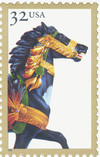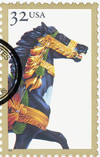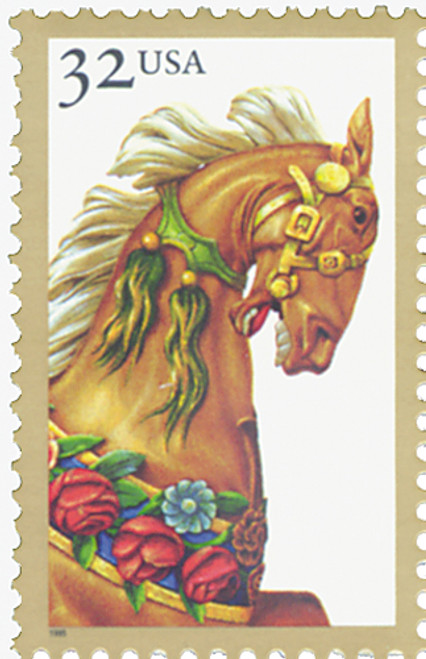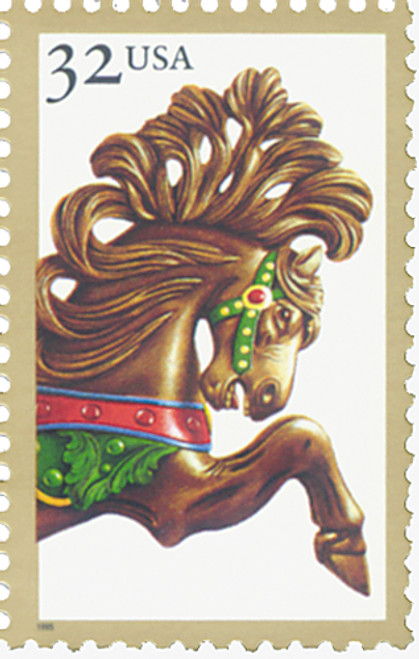
# 2977 - 1995 32c Carousel Horses: Pinto
U.S. #2977
1995 Pinto Carousel Horse
- This stamp is part of the American Folk Art Series
- It’s the second issuance of carousel animals
- Metallic gold ink borders each stamp
Stamp Category: Commemorative
Set: Carousel Horse
Value: 32¢
First Day of Issue: July 21, 1995
First Day City: Lahaska, PA
Quantity Issued: 3,125,000
Printed by: Ashton-Potter
Printing Method: Offset 160 subjects (10 across, 16 down)
Format: Panes of 20, vertical – 5 across and 4 down.
Perforations: 11.1
Why the stamp was issued: This stamp was issued due to the previous success of the 1988 carousel animals stamps issued as part of the American Folk Art Series.
About the stamp design: Paul Calle had designed the previous 1988 carousel animal stamps and was asked again to design the carousel horses. He used two carousel picture books as resources to his designs. The black Indian pony he used on this stamp was made in the Philadelphia Style around 1905.
Special design details: Ashton-Potter added microprinting into the design, but the Postal Service thought the phosphored paper and the metallic gold ink would discourage counterfeits. Also, poles to indicate carousel animals were left off the 1995 issues, while included in the 1988 issues because it was felt they were unnecessary.
About the printing process: Stamps were actually printed by a sub-contractor hired by Ashton-Potter. The company was Sterling Sommer located in Tonawanda, NY. They used an Akiyama 628 6-color sheetfed offset-press.
First Day City: The first-day ceremony was held at the Carousel World Museum in Lahaska, Pennsylvania, due to a suggestion made by Paul Calle. The golden lead horse, the black Indian horse, and the high-mane pony illustrated in #2976, #2977, and #2979 respectively, that Calle used as a reference, were present for the ceremony. Charlotte Dinger owner of the three horses brought them to the ceremony and left them on display for a few weeks.
History the stamp represents:
Up until the mid-1800’s rotation power for crudely-constructed carousels was provided by a horse or man pushing, pulling, or cranking the mechanism. It wasn’t until the 1860’s that Frederick Savage, an English engineer, designed a center-mounted steam engine capable of carrying up to four rows of horses on platforms that reached forty-eight feet in diameter. His overhead gears, which allowed the horses to move up and down, soon followed. These inventions revolutionized the carousel industry, making Savage’s portable roundabouts an enormous success.
Although carousels appeared in America as early as the 1800’s, it wasn’t until 1864 that Gustav Dentzel shipped his carousel from Germany and installed it in Philadelphia. The smashing success of his carousel spawned the Golden Age of the Carousel (1870-1930).
Daniel Muller, who carved the horses shown on the stamp, began his career carving horses for Dentzel. In 1899, he left the Dentzel firm to carve figures for the newly-formed Philadelphia Toboggan Company. His beautiful sensitively carved animals launched the PTC as a major force in the business. In 1902, along with his brother Alfred, he established the DC Muller & Brother Company.
U.S. #2977
1995 Pinto Carousel Horse
- This stamp is part of the American Folk Art Series
- It’s the second issuance of carousel animals
- Metallic gold ink borders each stamp
Stamp Category: Commemorative
Set: Carousel Horse
Value: 32¢
First Day of Issue: July 21, 1995
First Day City: Lahaska, PA
Quantity Issued: 3,125,000
Printed by: Ashton-Potter
Printing Method: Offset 160 subjects (10 across, 16 down)
Format: Panes of 20, vertical – 5 across and 4 down.
Perforations: 11.1
Why the stamp was issued: This stamp was issued due to the previous success of the 1988 carousel animals stamps issued as part of the American Folk Art Series.
About the stamp design: Paul Calle had designed the previous 1988 carousel animal stamps and was asked again to design the carousel horses. He used two carousel picture books as resources to his designs. The black Indian pony he used on this stamp was made in the Philadelphia Style around 1905.
Special design details: Ashton-Potter added microprinting into the design, but the Postal Service thought the phosphored paper and the metallic gold ink would discourage counterfeits. Also, poles to indicate carousel animals were left off the 1995 issues, while included in the 1988 issues because it was felt they were unnecessary.
About the printing process: Stamps were actually printed by a sub-contractor hired by Ashton-Potter. The company was Sterling Sommer located in Tonawanda, NY. They used an Akiyama 628 6-color sheetfed offset-press.
First Day City: The first-day ceremony was held at the Carousel World Museum in Lahaska, Pennsylvania, due to a suggestion made by Paul Calle. The golden lead horse, the black Indian horse, and the high-mane pony illustrated in #2976, #2977, and #2979 respectively, that Calle used as a reference, were present for the ceremony. Charlotte Dinger owner of the three horses brought them to the ceremony and left them on display for a few weeks.
History the stamp represents:
Up until the mid-1800’s rotation power for crudely-constructed carousels was provided by a horse or man pushing, pulling, or cranking the mechanism. It wasn’t until the 1860’s that Frederick Savage, an English engineer, designed a center-mounted steam engine capable of carrying up to four rows of horses on platforms that reached forty-eight feet in diameter. His overhead gears, which allowed the horses to move up and down, soon followed. These inventions revolutionized the carousel industry, making Savage’s portable roundabouts an enormous success.
Although carousels appeared in America as early as the 1800’s, it wasn’t until 1864 that Gustav Dentzel shipped his carousel from Germany and installed it in Philadelphia. The smashing success of his carousel spawned the Golden Age of the Carousel (1870-1930).
Daniel Muller, who carved the horses shown on the stamp, began his career carving horses for Dentzel. In 1899, he left the Dentzel firm to carve figures for the newly-formed Philadelphia Toboggan Company. His beautiful sensitively carved animals launched the PTC as a major force in the business. In 1902, along with his brother Alfred, he established the DC Muller & Brother Company.












